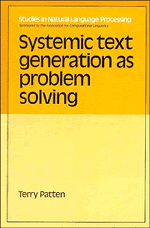Book contents
- Frontmatter
- Contents
- Dedication
- Preface
- 1 Introduction
- 2 Background I: AI problem solving
- 3 Background II: systemic grammar
- 4 The conflation
- 5 The formal model
- 6 The implementation
- 7 Related work in text generation
- 8 Conclusions
- Appendix A OPS5 tutorial
- Appendix B Sample texts
- Appendix C Excerpts from the grammar
- Notes
- Bibliography
- Index
Appendix B - Sample texts
Published online by Cambridge University Press: 26 March 2010
- Frontmatter
- Contents
- Dedication
- Preface
- 1 Introduction
- 2 Background I: AI problem solving
- 3 Background II: systemic grammar
- 4 The conflation
- 5 The formal model
- 6 The implementation
- 7 Related work in text generation
- 8 Conclusions
- Appendix A OPS5 tutorial
- Appendix B Sample texts
- Appendix C Excerpts from the grammar
- Notes
- Bibliography
- Index
Summary
The following are some examples of the text produced by SLANG-I (parts of the grammar used are in Appendix C). Recall that SLANG-I was not provided with an orthographic stratum, so there are no “an”s, punctuation or capitalization– except as provided by the systems at the word rank (the dictionary). To avoid confusion, line spacing has been added in lieu of punctuation where necessary.
In all cases SLANG-I generates the text one clause at a time. Although some of the samples are of paragraph length, it should not be inferred that SLANG-I has done any text planning; all the examples are collections of clauses which, as far as SLANG-I is concerned, were generated independently.
Explanation for a hypothetical expert system
The following example was generated to demonstrate the grammar, and to illustrate the utility of flexible natural-language generation in expert systems.
Suppose there is a hypothetical medical expert system interviewing the mother of a patient named Mary (following an example in Hasling et al., 1984). The mother has reported that Mary has been suffering from stiff neck muscles and headaches. At this point the hypothetical dialogue continues:
Does Mary have a fever?
*WHY
Mary's mother wants to know why she is being asked this question. The following text was generated by preselecting the grammatical features by hand. The construction of a good semantic stratum in this domain would be a major project in itself.
- Type
- Chapter
- Information
- Systemic Text Generation as Problem Solving , pp. 161 - 185Publisher: Cambridge University PressPrint publication year: 1988

